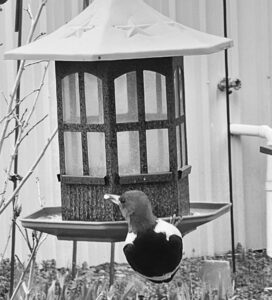Backyard Gardener: Colonial ‘kitchen gardens’ offer taste of history

(Backyard Gardener - Photo Illustration - MetroCreativeConnection)
Hello Mid-Ohio Valley gardeners and farmers! This week I want to discuss planting a historical or Colonial Kitchen garden. The Wood County Master Gardeners planted a kitchen garden at Henderson Hall, near Williamstown. This was the home of the Henderson family in Williamstown for five generations. Vegetables and herbs grown in the Heritage Garden were based on letters from the Henderson family researched by Master Gardener volunteers.
First let me say there were no specific “herb gardens.” Many consider these “kitchen gardens” because they were very practical and served the purpose of providing food, medicine, seasonings, and fragrance. Herbs were mixed in with vegetable plantings. However, pungent herbs were separated from vegetables.
Larger vegetables such as snap or pole beans, sweet corn and pumpkins were grown in the larger, outlying fields. Fruit trees were incorporated into the garden from outside edges to focal points in the center of the garden squares
Most European and colonial gardens developed from Tudor and Medieval gardening styles. Colonial gardens in the United States were quite diverse, drawing influence from early immigrants and their own heritage. Colonists from France, England, the Netherlands and Germany created gardens that reflected traditions from their homeland.
Plants brought to the colonies included vegetables, herbs, flowers, bulbs, and fruit trees. They were placed in gardens with plants native to the United States, including tobacco, corn and other vegetables, trees, flowering shrubs, vines, and wildflowers.
Corn was a major food source for the colonies and Native Americans. Colonial families grew quite a bit of corn for making corn meal. Native Americans had been using corn ground into meal and flour for years in their cooking and people in the colonies quickly adapted to growing this staple food.
A surge in popularity for cornmeal occurred around the American Civil War. Corn was plentiful and cheap, and cornbread and other dishes made from cornmeal were a quick and simple meal.
Gardens differed depending on the colonists’ needs. Garden dimensions were proportional to the size of their family. In rural areas gardens were planted around structures such as buildings, fences, livestock pens, walkways, and surrounding work areas. Most colonists did not place plants around the foundation of the home, this practice emerged later in the Victorian era.
Most colonial gardens were about function and efficiency. Gardens would be laid out in square or rectangular shaped raised-beds framed with tree saplings. This allowed gardeners access to the entire gardening space. Plants were usually in tightly packed rows to save space and walkways were created from soil, gravel, or crushed clamshells, and surrounding each bed.
Hedges or picket fences surrounding the garden to protect plants from animals and damaging wind but some would use wooden fences. A larger, central walkway leading to the focal point in the garden that was usually a well or similar stone feature.
Colonists also took advantage of hills on their property and planted crops such as peas, lettuce, and radishes earlier in the season on southern-facing slopes to take advantage of the warmer soil.
When planting a garden colonists considered things such as sunlight and shade, proximity to water, and honey bees. Most gardeners had beehives very close to the garden to promote pollination and help plants to flourish. Herbs and flowers were also used as ingredients in many perfumes and soaps made in the colonies.
Caring for an herb garden was a vital part of colonial life. Harvesting, drying, and storing properly was important because dried herbs held their essence for less than six months. Planting, weeding, and harvesting were all important aspects of care.
Many cooking and seasoning herbs were grown in colonial gardens. Rosemary, thyme, basil, chives, mint, sage, marjoram, savory, and oregano were tasty and aromatic herbs that were frequently cultivated.
An important use of herbs was for medicine. Horehound was popular for gastric upsets and sassafras was important for dental cleanliness. Cinquefoil, an astringent, was used for night sweats. Coriander was used for gastrointestinal problems and bad breath.
At the time of the Revolutionary War, most colonists with a kitchen garden grew medicinal herbs such hyssop, lavender, comfrey, and fennel, interspersed with vegetables and flowers in their garden. Soldiers at this time would pack a number of herbs that worked best on ailments they normally experienced including chamomile, mint, licorice, yarrow, horsetail, and sage.
Beans, squash and cabbage were popular garden vegetables. Greens were often listed in colonial recipes. These included kale, mustard, Swiss chard, and turnip greens.
Parsnips, carrots and potatoes were grown and often boiled or cooked into stews. Gardens that contained small vegetables such as leaks, onions, garlic, carrots, and cabbage herbs, and flowers were placed near a house door to allow quick and easy access.
There were a variety of flowers and flowering shrubs in the colonial garden including azaleas, sunflowers, hydrangeas, roses, English ivy, clematis, holly, and lilies. Columbine, crocuses, bee balm, grape hyacinth, evening primrose, star-of-bethlehem, and tulips were others grown. Flowers were also used as decorations in homes, churches, taverns, hair, and clothing.
American Founding Father President Thomas Jefferson was an avid gardener. The English pea was his favorite vegetable and he grew 23 different varieties in his garden at Monticello. Jefferson also documented harvesting lettuce every month of the year and urged gardeners to sow a thimbleful of lettuce seeds every week from early spring to September.
Planting a colonial or kitchen garden will give you a glimpse into the rich history of gardening here in America. A mix of plants and traditions from “Old World” Europe and the “New World” of North America shaped gardening and culture in our great country. Contact me at the Wood County WVU Extension Office 304-424-1960 or e-mail me at jj.barrett@mail.wvu.edu with questions. Good Luck and Happy Gardening!
***
Question of the Week: I have a spotted beetle on my asparagus. What is it?
Most likely it is an asparagus beetle. Two species of asparagus beetles are found in West Virginia including the common asparagus beetle (Crioceris asparagi) and the spotted asparagus beetle (Crioceris duodecimpunctata).
Both types of asparagus beetle adults are ¼-inch long with oval-shaped bodies and moderate-length antennae. The adult common asparagus beetle is bluish-black with six cream-colored spots on its back. Adult spotted asparagus beetles are reddish-orange with 12 black spots. The spotted asparagus beetle is often mistaken for a lady beetle but has a slightly more elongated body than their lookalike.
The larvae of both species are slug-like with visible heads and legs. Common asparagus beetle larvae are light gray with a black head and spotted asparagus beetle larvae are orange. Larvae measure about 6/100 inch at hatching, and as they develop they become plump and attain a length of about 1/3 inch.
Asparagus beetles overwinter as adults in plant debris. In spring, beetles feed on the tender asparagus spears and tips of buds, then deposit their eggs on spears. Eggs hatch in about one week, and larvae join the adults in feeding on the spears and ferns.
Adults and larvae chew on shoots and foliage of asparagus plants. Asparagus spears become brown and bend over into a hook when either species of asparagus beetle adults feed on the spears. The common asparagus beetle larvae and adults can also feed on the ferns.
Beetles feeding on the leaves weaken the plant and reduce the plant’s ability to provide sufficient nutrients for the following season. Fewer leaves also make asparagus a target for Fusarium, a fungal disease.
The spotted asparagus beetle larvae feed on asparagus berries and do not affect the health of the plant. The presence of common asparagus beetle eggs on the spears can make the asparagus unappealing. Eggs are laid on shoots around the time of harvest. Presence of eggs on the spears is objectionable to some, although the eggs themselves cause no damage.
The following are some recommended control measures. Handpicking, especially in small gardens, can be effective. Drop the adults and larvae in a pail filled with soapy water.
Harvest spears as early as possible. Beetles are attracted to plants with an abundance of foliage. Gardeners can leave a small portion of their crop unharvested as a decoy for beetles to congregate while the rest of the crop is harvested. Thoroughly remove all plant debris from the garden and surrounding areas after harvest to eliminate beetle overwintering sites.
Important natural enemies of asparagus beetles include several species of lady beetles and a tiny parasitic wasp (Tetrastichus asparagi). This wasp feeds on eggs and small larvae.
If you decide to apply an insecticide, spray or dust with botanical insecticides, such as those containing pyrethrins as the active ingredient. Apply treatments when larvae are first noticed feeding on plants. Organic products containing spinosad (Captain Jack’s Dead Bug Brew©) can also be used. Since asparagus requires frequent harvests, be sure to consider the pre-harvest interval (PHI) located on the insecticide label.






